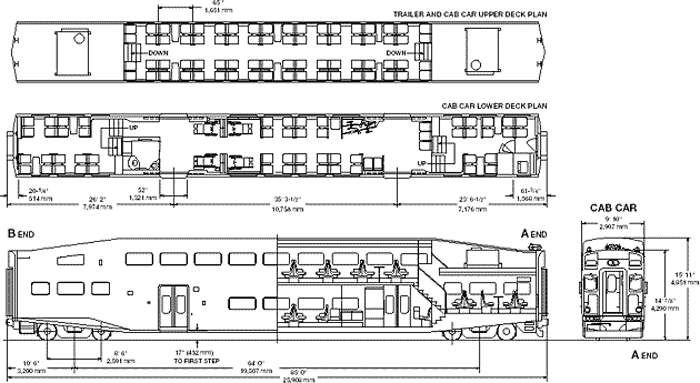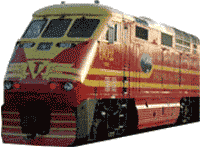Interstate Highway number 5 (I5) crosses in a north-south direction through the heart of Seattle. For those unfortunate enough to drive it on a regular basis this photo is a common sight. Drivers, given the proper circumstances, wouldn't you prefer to use Sounder?

While expansion of light-rail transit is currently underway in Seattle the Burlington Northern Santa Fe Railway tracks have provided commuters gridlock relief since September 2000 when Sounder first initiated public service between Seattle and Tacoma with two daily trains. Since that date service has expanded northwards to include an Edmonds and Everett connection with Seattle on 21 Dec 2003. Additional route expansions south from Tacoma now reach Lakewood.
In August 2003 the 1.6 mile Tacoma Link light rail line began carrying passengers from Sounder's Tacoma Dome Station to the Theatre District. Tacoma Link passengers ride FREE in electric-powered trams beneath overhead catenary which travel at street level stopping at five stations along the route, Tacoma Dome Station, South 25th Street, Union Station by South 19th, the Convention Center at South 15th, and in the Theater District at South 9th street. Trams run daily, generally every 20 minutes during the day.
| Length | 85 feet |
| Width | 9 feet 10 inches |
| Weight | 118,500 pounds |
| Capacity | 140 passengers 4 wheelchairs |
| Manufacturer | Bombardier |
| Built | 1999, 2000, 2001 |
| Quantity | 18 cab cars 40 coaches |
| Cost | US$107 million |

Sounder utilizes push-pull trains consisting of Bombardier bi-level coaches and cab control cars manufactured in Thunder Bay, Ontario, assembled in Barre, Vermont, and Plattsburg, New York.
Sounder cars feature two full decks with intermediate end decks that allow for higher ceilings and better seating, stairways, and door positioning. The low-level platform doors permit a full carload of passengers to enter or leave within 90 seconds, minimizing platform congestion.
Each Sounder coach has an attractive interior with tinted windows, restrooms, worktables, surge-protected power outlets for laptop computers, wheelchair accessibility, overhead storage racks, bicycle racks, and an electronic public address system.
Coaches have seating for approximately 140 passengers with a standing room "crush load" of 360. These bi-level carriages are easily identifiable and shaped like elongated octagons.
The following modifications have been made to Sounder equipment:
- Station stops, safety information, time of day, and other special information is broadcast on all Sounder trains, using a variable message system. Audio announcements, including station stops and safety information, are also provided;
- Sound Transit modifies its equipment where necessary with federally-mandated floor strips that glow in the dark to direct passengers to exits in case of an emergency;
- Sound Transit is equipping all its coaches with Wi-Fi for onboard use;
- All Sounder trains now include GPS (Global Positioning System) for exact vehicle location information and to alert passengers at stations on train arrival times.
| Length | 58 feet 7 inches |
| Width | 10 feet 7 inches |
| Weight | 285,600 pounds |
| Power | 3,000 horsepower |
| Fuel Capacity | 1,800 US gallons |
| Manufacturer | GM EMD model F59PHI |
| Built | 1999, 2000, 2001 |
| Quantity | 11 locomotives |
| Cost | US$26.5 million |

Sounder trains are powered by Electro-Motive F59PHI diesel-electric locomotives similar to equipment on other North American commuter lines.
To supply electrical power for passenger service, the F59PHI is equipped with a secondary electrical generator referred to as a HEP (Head End Power) unit. The head-end generator generates AC power at 480 volts AC, 750 amps, or about 500 kilowatts to provide power to the passenger coaches for lighting, electric heating, and air conditioning. The head-end generator is powered by a second diesel engine dedicated to it. With this arrangement, the prime mover is not burdened by head-end power generation requirements. It is used solely for supplying tractive effort.
Sounder currently operates 18 commuter trains per day to and from Seattle, the center hub of the system. In the morning 3 trains depart Everett southbound and 5 trains leave Tacoma northbound running inbound to Seattle. These are reversed in late afternoon for the return transit. All trains operate only during weekdays with approximately 30 minutes separation between each train. The journey between Tacoma and Seattle takes one hour while Everett to Seattle is also about an hour. Additionally, a so-called "reverse commute", adds 2 additional trains each day to run against the normal flow of traffic between Tacoma and Seattle.
The current adult fare between Lakewood and Seattle is US$5.75. The adult fare between Everett and Seattle is US$5.00
To celebrate and promote the "reverse commute" Sound Transit unveiled a special locomotive painted and lettered in a special design dubbed the City of Destiny, a name chosen to honour Tacoma's motto of more than 100 years. This special F59PHI locomotive pulled six Sounder cars between Seattle, Tukwila, Kent, Auburn, Sumner, Puyallup, and Freighthouse Square where passengers could connect with Sound Transit's Tacoma Link tram service.


